A Fifteen-Year Analysis of UK Macroeconomic Trends and Indicators
VerifiedAdded on 2020/10/22
|19
|2467
|433
Report
AI Summary
This research essay provides a comprehensive analysis of the macroeconomics of the United Kingdom, focusing on key indicators and trends from 2003 to 2017. The report begins with an introduction to macroeconomics, defining its scope and importance. The main body of the essay then delves into the sources of data, study period, and data collection methods, including GDP, CPI, unemployment rates, and trade balance. The analysis includes detailed tables and interpretations of the data, examining the relationship between various economic factors such as money supply, inflation, and unemployment. The essay also explores factors influencing GDP, such as capital formation, natural resources, human resources, and technological advancements. The study concludes with a commentary on the UK's economic performance, referencing the service sector's significant contribution and the impact of factors like Brexit. Finally, the essay includes a list of references and appendices supporting the analysis. This report offers a valuable insight into the UK's economic landscape during the specified period.
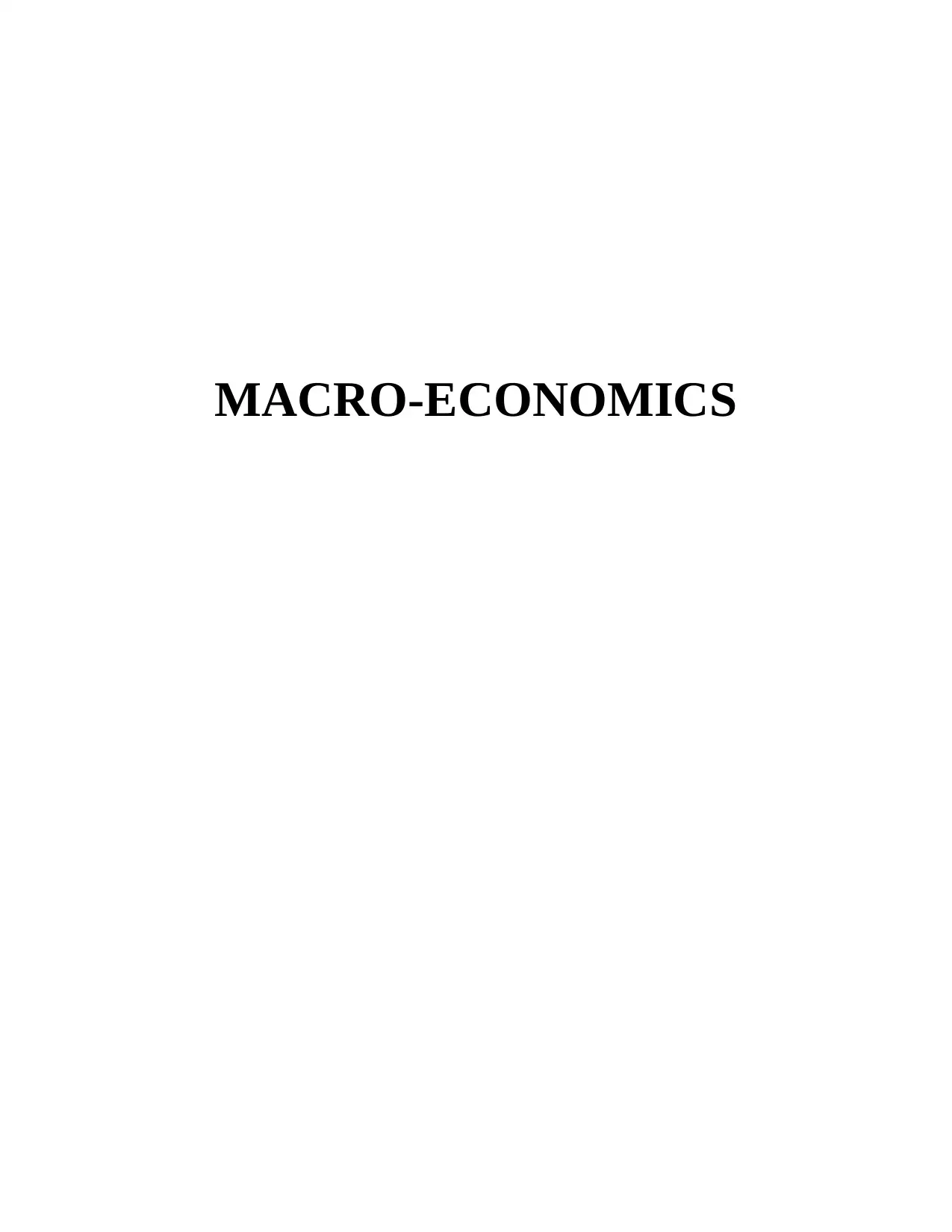
MACRO-ECONOMICS
Paraphrase This Document
Need a fresh take? Get an instant paraphrase of this document with our AI Paraphraser
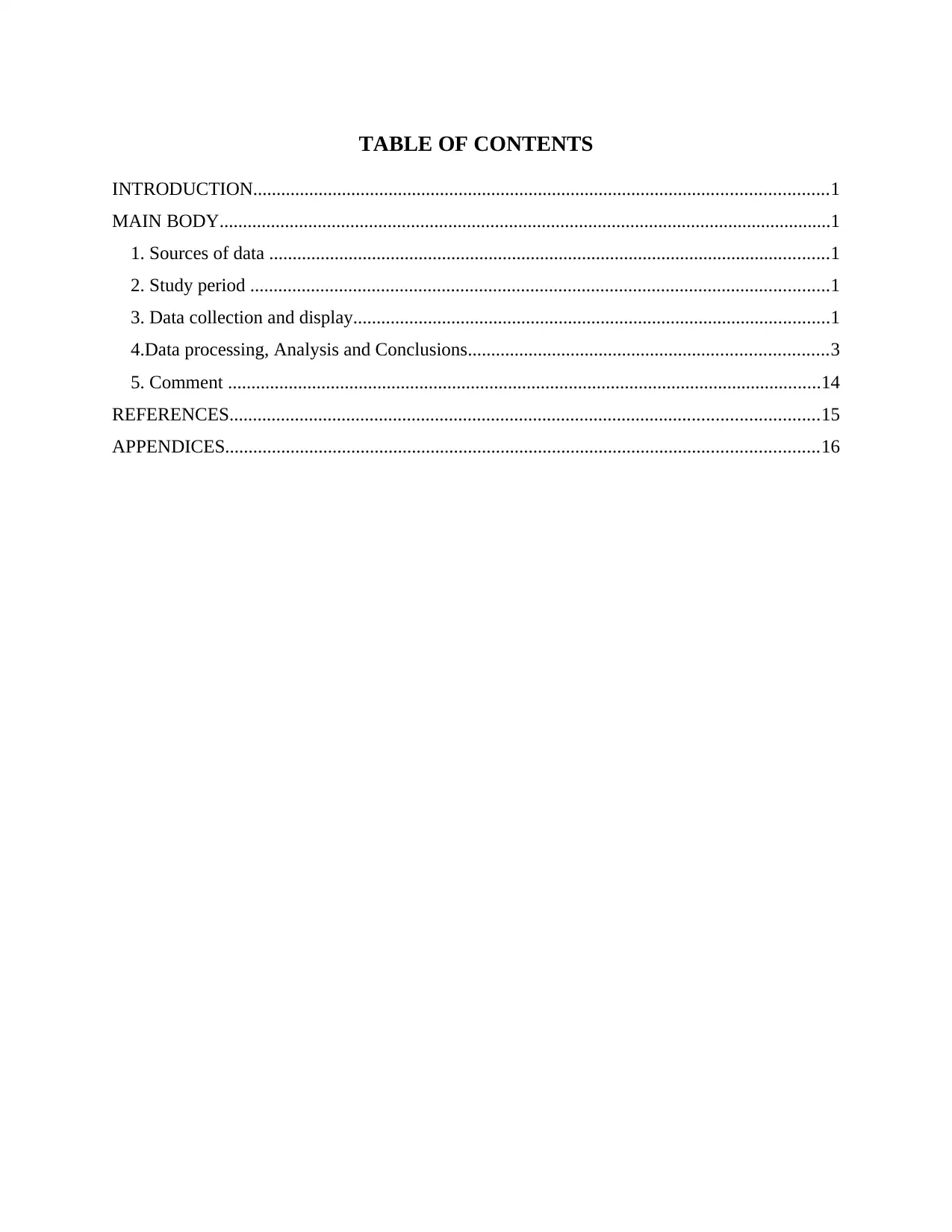
TABLE OF CONTENTS
INTRODUCTION...........................................................................................................................1
MAIN BODY...................................................................................................................................1
1. Sources of data ........................................................................................................................1
2. Study period ............................................................................................................................1
3. Data collection and display......................................................................................................1
4.Data processing, Analysis and Conclusions.............................................................................3
5. Comment ...............................................................................................................................14
REFERENCES..............................................................................................................................15
APPENDICES...............................................................................................................................16
INTRODUCTION...........................................................................................................................1
MAIN BODY...................................................................................................................................1
1. Sources of data ........................................................................................................................1
2. Study period ............................................................................................................................1
3. Data collection and display......................................................................................................1
4.Data processing, Analysis and Conclusions.............................................................................3
5. Comment ...............................................................................................................................14
REFERENCES..............................................................................................................................15
APPENDICES...............................................................................................................................16
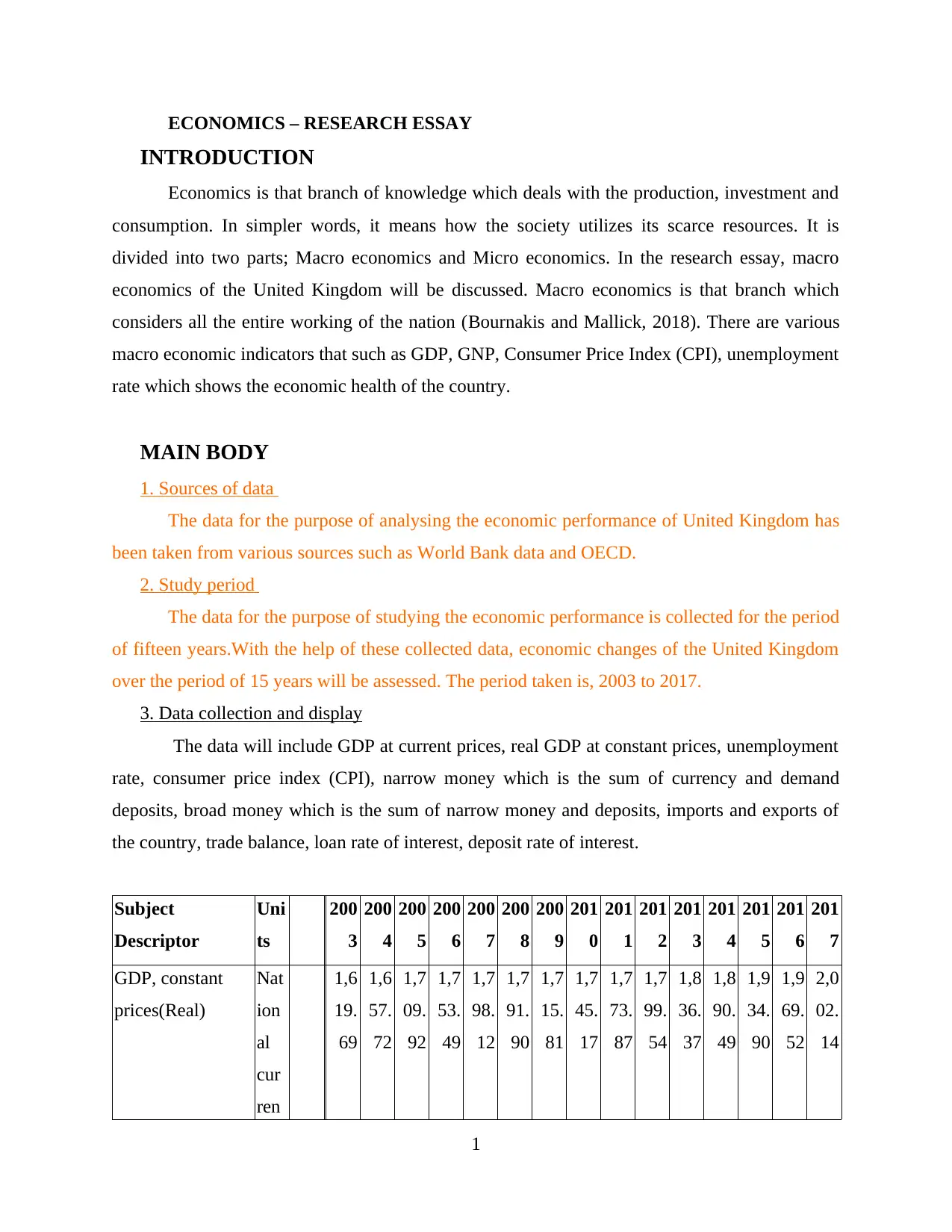
ECONOMICS – RESEARCH ESSAY
INTRODUCTION
Economics is that branch of knowledge which deals with the production, investment and
consumption. In simpler words, it means how the society utilizes its scarce resources. It is
divided into two parts; Macro economics and Micro economics. In the research essay, macro
economics of the United Kingdom will be discussed. Macro economics is that branch which
considers all the entire working of the nation (Bournakis and Mallick, 2018). There are various
macro economic indicators that such as GDP, GNP, Consumer Price Index (CPI), unemployment
rate which shows the economic health of the country.
MAIN BODY
1. Sources of data
The data for the purpose of analysing the economic performance of United Kingdom has
been taken from various sources such as World Bank data and OECD.
2. Study period
The data for the purpose of studying the economic performance is collected for the period
of fifteen years.With the help of these collected data, economic changes of the United Kingdom
over the period of 15 years will be assessed. The period taken is, 2003 to 2017.
3. Data collection and display
The data will include GDP at current prices, real GDP at constant prices, unemployment
rate, consumer price index (CPI), narrow money which is the sum of currency and demand
deposits, broad money which is the sum of narrow money and deposits, imports and exports of
the country, trade balance, loan rate of interest, deposit rate of interest.
Subject
Descriptor
Uni
ts
200
3
200
4
200
5
200
6
200
7
200
8
200
9
201
0
201
1
201
2
201
3
201
4
201
5
201
6
201
7
GDP, constant
prices(Real)
Nat
ion
al
cur
ren
1,6
19.
69
1,6
57.
72
1,7
09.
92
1,7
53.
49
1,7
98.
12
1,7
91.
90
1,7
15.
81
1,7
45.
17
1,7
73.
87
1,7
99.
54
1,8
36.
37
1,8
90.
49
1,9
34.
90
1,9
69.
52
2,0
02.
14
1
INTRODUCTION
Economics is that branch of knowledge which deals with the production, investment and
consumption. In simpler words, it means how the society utilizes its scarce resources. It is
divided into two parts; Macro economics and Micro economics. In the research essay, macro
economics of the United Kingdom will be discussed. Macro economics is that branch which
considers all the entire working of the nation (Bournakis and Mallick, 2018). There are various
macro economic indicators that such as GDP, GNP, Consumer Price Index (CPI), unemployment
rate which shows the economic health of the country.
MAIN BODY
1. Sources of data
The data for the purpose of analysing the economic performance of United Kingdom has
been taken from various sources such as World Bank data and OECD.
2. Study period
The data for the purpose of studying the economic performance is collected for the period
of fifteen years.With the help of these collected data, economic changes of the United Kingdom
over the period of 15 years will be assessed. The period taken is, 2003 to 2017.
3. Data collection and display
The data will include GDP at current prices, real GDP at constant prices, unemployment
rate, consumer price index (CPI), narrow money which is the sum of currency and demand
deposits, broad money which is the sum of narrow money and deposits, imports and exports of
the country, trade balance, loan rate of interest, deposit rate of interest.
Subject
Descriptor
Uni
ts
200
3
200
4
200
5
200
6
200
7
200
8
200
9
201
0
201
1
201
2
201
3
201
4
201
5
201
6
201
7
GDP, constant
prices(Real)
Nat
ion
al
cur
ren
1,6
19.
69
1,6
57.
72
1,7
09.
92
1,7
53.
49
1,7
98.
12
1,7
91.
90
1,7
15.
81
1,7
45.
17
1,7
73.
87
1,7
99.
54
1,8
36.
37
1,8
90.
49
1,9
34.
90
1,9
69.
52
2,0
02.
14
1
⊘ This is a preview!⊘
Do you want full access?
Subscribe today to unlock all pages.

Trusted by 1+ million students worldwide
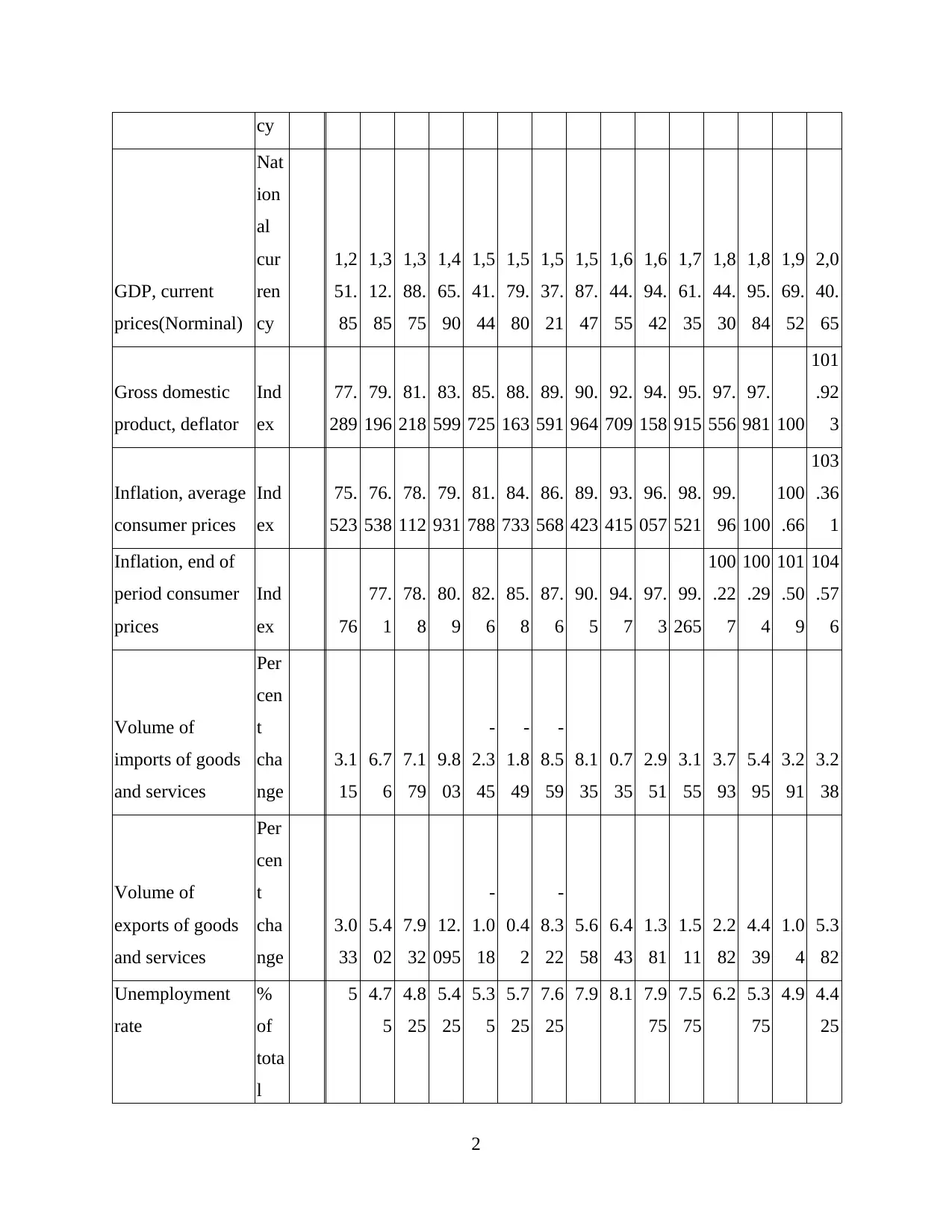
cy
GDP, current
prices(Norminal)
Nat
ion
al
cur
ren
cy
1,2
51.
85
1,3
12.
85
1,3
88.
75
1,4
65.
90
1,5
41.
44
1,5
79.
80
1,5
37.
21
1,5
87.
47
1,6
44.
55
1,6
94.
42
1,7
61.
35
1,8
44.
30
1,8
95.
84
1,9
69.
52
2,0
40.
65
Gross domestic
product, deflator
Ind
ex
77.
289
79.
196
81.
218
83.
599
85.
725
88.
163
89.
591
90.
964
92.
709
94.
158
95.
915
97.
556
97.
981 100
101
.92
3
Inflation, average
consumer prices
Ind
ex
75.
523
76.
538
78.
112
79.
931
81.
788
84.
733
86.
568
89.
423
93.
415
96.
057
98.
521
99.
96 100
100
.66
103
.36
1
Inflation, end of
period consumer
prices
Ind
ex 76
77.
1
78.
8
80.
9
82.
6
85.
8
87.
6
90.
5
94.
7
97.
3
99.
265
100
.22
7
100
.29
4
101
.50
9
104
.57
6
Volume of
imports of goods
and services
Per
cen
t
cha
nge
3.1
15
6.7
6
7.1
79
9.8
03
-
2.3
45
-
1.8
49
-
8.5
59
8.1
35
0.7
35
2.9
51
3.1
55
3.7
93
5.4
95
3.2
91
3.2
38
Volume of
exports of goods
and services
Per
cen
t
cha
nge
3.0
33
5.4
02
7.9
32
12.
095
-
1.0
18
0.4
2
-
8.3
22
5.6
58
6.4
43
1.3
81
1.5
11
2.2
82
4.4
39
1.0
4
5.3
82
Unemployment
rate
%
of
tota
l
5 4.7
5
4.8
25
5.4
25
5.3
5
5.7
25
7.6
25
7.9 8.1 7.9
75
7.5
75
6.2 5.3
75
4.9 4.4
25
2
GDP, current
prices(Norminal)
Nat
ion
al
cur
ren
cy
1,2
51.
85
1,3
12.
85
1,3
88.
75
1,4
65.
90
1,5
41.
44
1,5
79.
80
1,5
37.
21
1,5
87.
47
1,6
44.
55
1,6
94.
42
1,7
61.
35
1,8
44.
30
1,8
95.
84
1,9
69.
52
2,0
40.
65
Gross domestic
product, deflator
Ind
ex
77.
289
79.
196
81.
218
83.
599
85.
725
88.
163
89.
591
90.
964
92.
709
94.
158
95.
915
97.
556
97.
981 100
101
.92
3
Inflation, average
consumer prices
Ind
ex
75.
523
76.
538
78.
112
79.
931
81.
788
84.
733
86.
568
89.
423
93.
415
96.
057
98.
521
99.
96 100
100
.66
103
.36
1
Inflation, end of
period consumer
prices
Ind
ex 76
77.
1
78.
8
80.
9
82.
6
85.
8
87.
6
90.
5
94.
7
97.
3
99.
265
100
.22
7
100
.29
4
101
.50
9
104
.57
6
Volume of
imports of goods
and services
Per
cen
t
cha
nge
3.1
15
6.7
6
7.1
79
9.8
03
-
2.3
45
-
1.8
49
-
8.5
59
8.1
35
0.7
35
2.9
51
3.1
55
3.7
93
5.4
95
3.2
91
3.2
38
Volume of
exports of goods
and services
Per
cen
t
cha
nge
3.0
33
5.4
02
7.9
32
12.
095
-
1.0
18
0.4
2
-
8.3
22
5.6
58
6.4
43
1.3
81
1.5
11
2.2
82
4.4
39
1.0
4
5.3
82
Unemployment
rate
%
of
tota
l
5 4.7
5
4.8
25
5.4
25
5.3
5
5.7
25
7.6
25
7.9 8.1 7.9
75
7.5
75
6.2 5.3
75
4.9 4.4
25
2
Paraphrase This Document
Need a fresh take? Get an instant paraphrase of this document with our AI Paraphraser
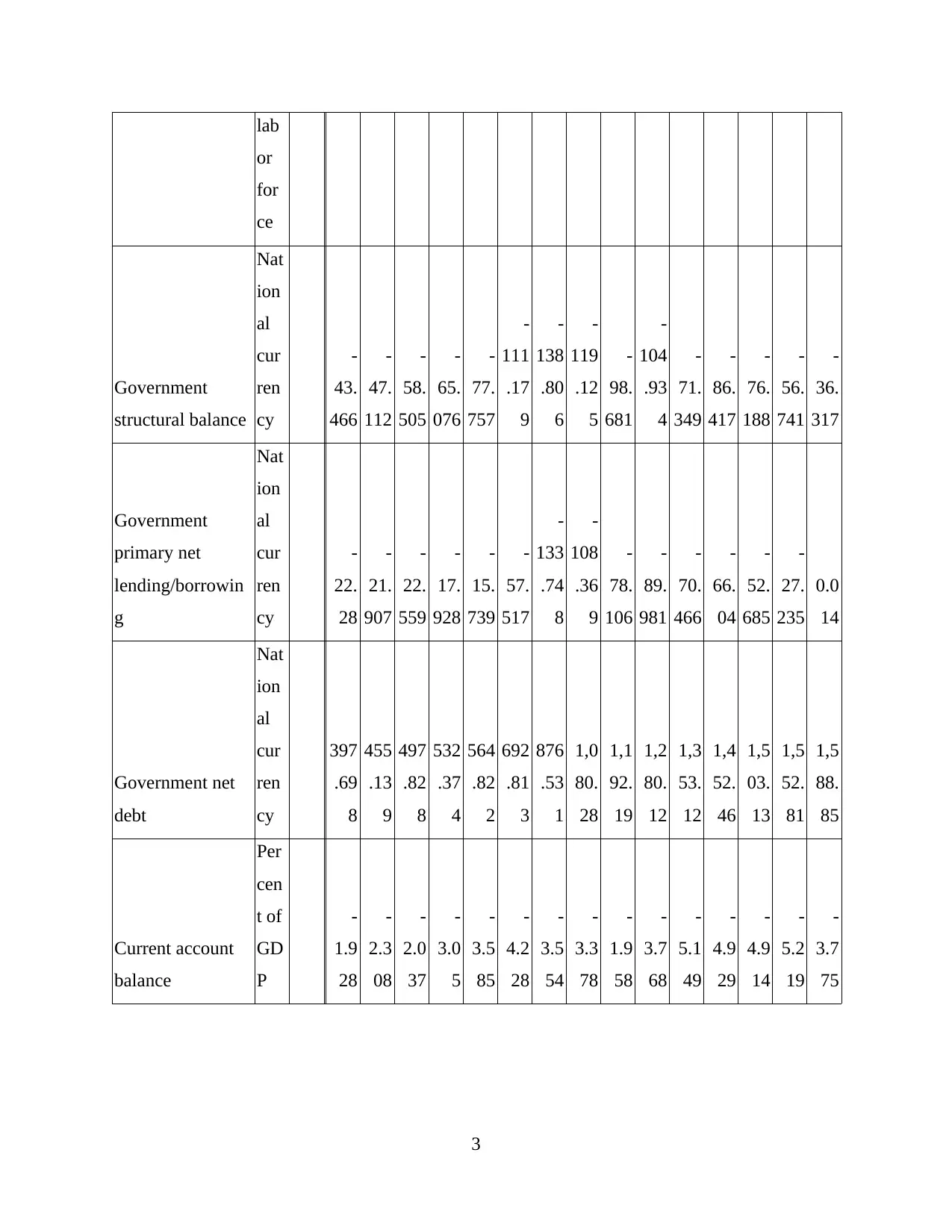
lab
or
for
ce
Government
structural balance
Nat
ion
al
cur
ren
cy
-
43.
466
-
47.
112
-
58.
505
-
65.
076
-
77.
757
-
111
.17
9
-
138
.80
6
-
119
.12
5
-
98.
681
-
104
.93
4
-
71.
349
-
86.
417
-
76.
188
-
56.
741
-
36.
317
Government
primary net
lending/borrowin
g
Nat
ion
al
cur
ren
cy
-
22.
28
-
21.
907
-
22.
559
-
17.
928
-
15.
739
-
57.
517
-
133
.74
8
-
108
.36
9
-
78.
106
-
89.
981
-
70.
466
-
66.
04
-
52.
685
-
27.
235
0.0
14
Government net
debt
Nat
ion
al
cur
ren
cy
397
.69
8
455
.13
9
497
.82
8
532
.37
4
564
.82
2
692
.81
3
876
.53
1
1,0
80.
28
1,1
92.
19
1,2
80.
12
1,3
53.
12
1,4
52.
46
1,5
03.
13
1,5
52.
81
1,5
88.
85
Current account
balance
Per
cen
t of
GD
P
-
1.9
28
-
2.3
08
-
2.0
37
-
3.0
5
-
3.5
85
-
4.2
28
-
3.5
54
-
3.3
78
-
1.9
58
-
3.7
68
-
5.1
49
-
4.9
29
-
4.9
14
-
5.2
19
-
3.7
75
3
or
for
ce
Government
structural balance
Nat
ion
al
cur
ren
cy
-
43.
466
-
47.
112
-
58.
505
-
65.
076
-
77.
757
-
111
.17
9
-
138
.80
6
-
119
.12
5
-
98.
681
-
104
.93
4
-
71.
349
-
86.
417
-
76.
188
-
56.
741
-
36.
317
Government
primary net
lending/borrowin
g
Nat
ion
al
cur
ren
cy
-
22.
28
-
21.
907
-
22.
559
-
17.
928
-
15.
739
-
57.
517
-
133
.74
8
-
108
.36
9
-
78.
106
-
89.
981
-
70.
466
-
66.
04
-
52.
685
-
27.
235
0.0
14
Government net
debt
Nat
ion
al
cur
ren
cy
397
.69
8
455
.13
9
497
.82
8
532
.37
4
564
.82
2
692
.81
3
876
.53
1
1,0
80.
28
1,1
92.
19
1,2
80.
12
1,3
53.
12
1,4
52.
46
1,5
03.
13
1,5
52.
81
1,5
88.
85
Current account
balance
Per
cen
t of
GD
P
-
1.9
28
-
2.3
08
-
2.0
37
-
3.0
5
-
3.5
85
-
4.2
28
-
3.5
54
-
3.3
78
-
1.9
58
-
3.7
68
-
5.1
49
-
4.9
29
-
4.9
14
-
5.2
19
-
3.7
75
3
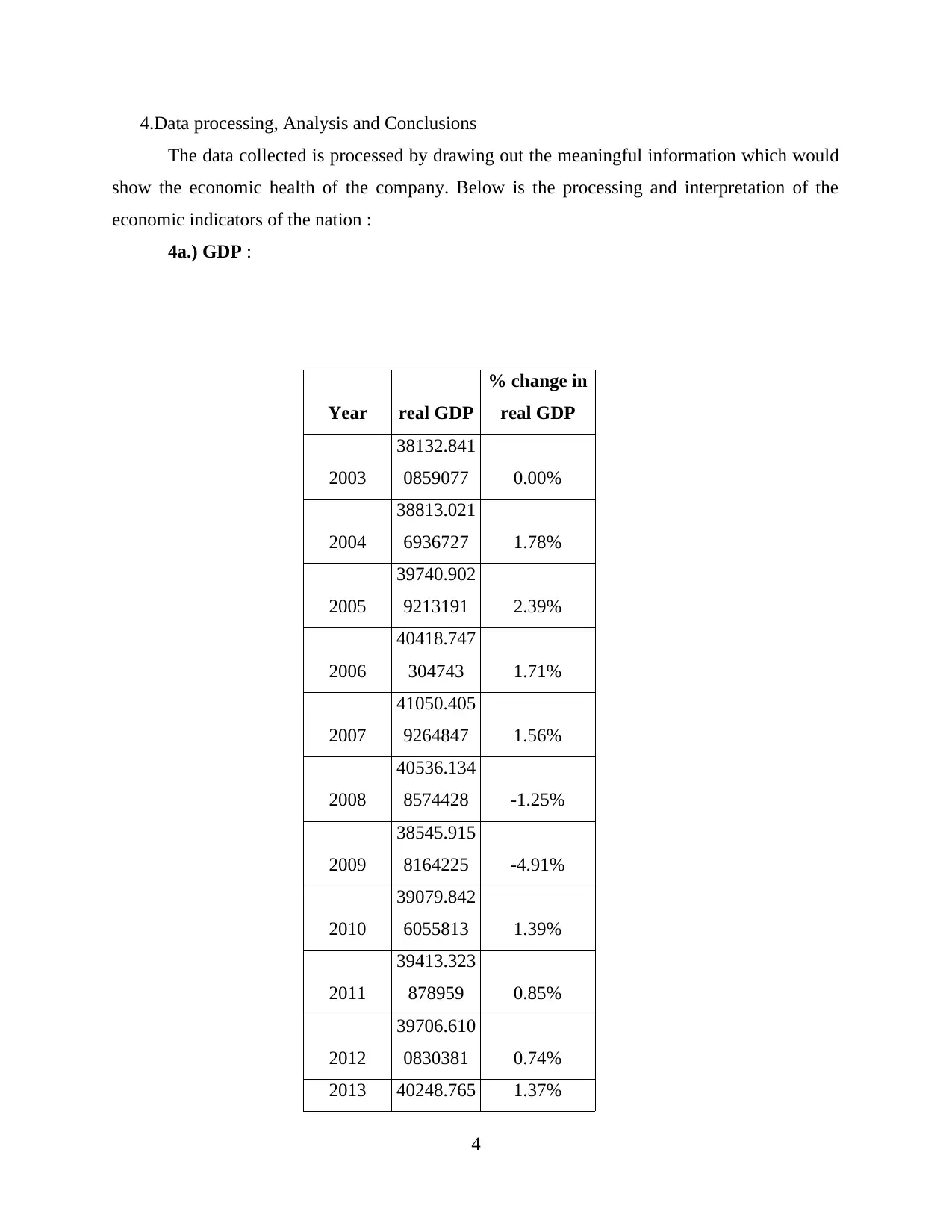
4.Data processing, Analysis and Conclusions
The data collected is processed by drawing out the meaningful information which would
show the economic health of the company. Below is the processing and interpretation of the
economic indicators of the nation :
4a.) GDP :
Year real GDP
% change in
real GDP
2003
38132.841
0859077 0.00%
2004
38813.021
6936727 1.78%
2005
39740.902
9213191 2.39%
2006
40418.747
304743 1.71%
2007
41050.405
9264847 1.56%
2008
40536.134
8574428 -1.25%
2009
38545.915
8164225 -4.91%
2010
39079.842
6055813 1.39%
2011
39413.323
878959 0.85%
2012
39706.610
0830381 0.74%
2013 40248.765 1.37%
4
The data collected is processed by drawing out the meaningful information which would
show the economic health of the company. Below is the processing and interpretation of the
economic indicators of the nation :
4a.) GDP :
Year real GDP
% change in
real GDP
2003
38132.841
0859077 0.00%
2004
38813.021
6936727 1.78%
2005
39740.902
9213191 2.39%
2006
40418.747
304743 1.71%
2007
41050.405
9264847 1.56%
2008
40536.134
8574428 -1.25%
2009
38545.915
8164225 -4.91%
2010
39079.842
6055813 1.39%
2011
39413.323
878959 0.85%
2012
39706.610
0830381 0.74%
2013 40248.765 1.37%
4
⊘ This is a preview!⊘
Do you want full access?
Subscribe today to unlock all pages.

Trusted by 1+ million students worldwide
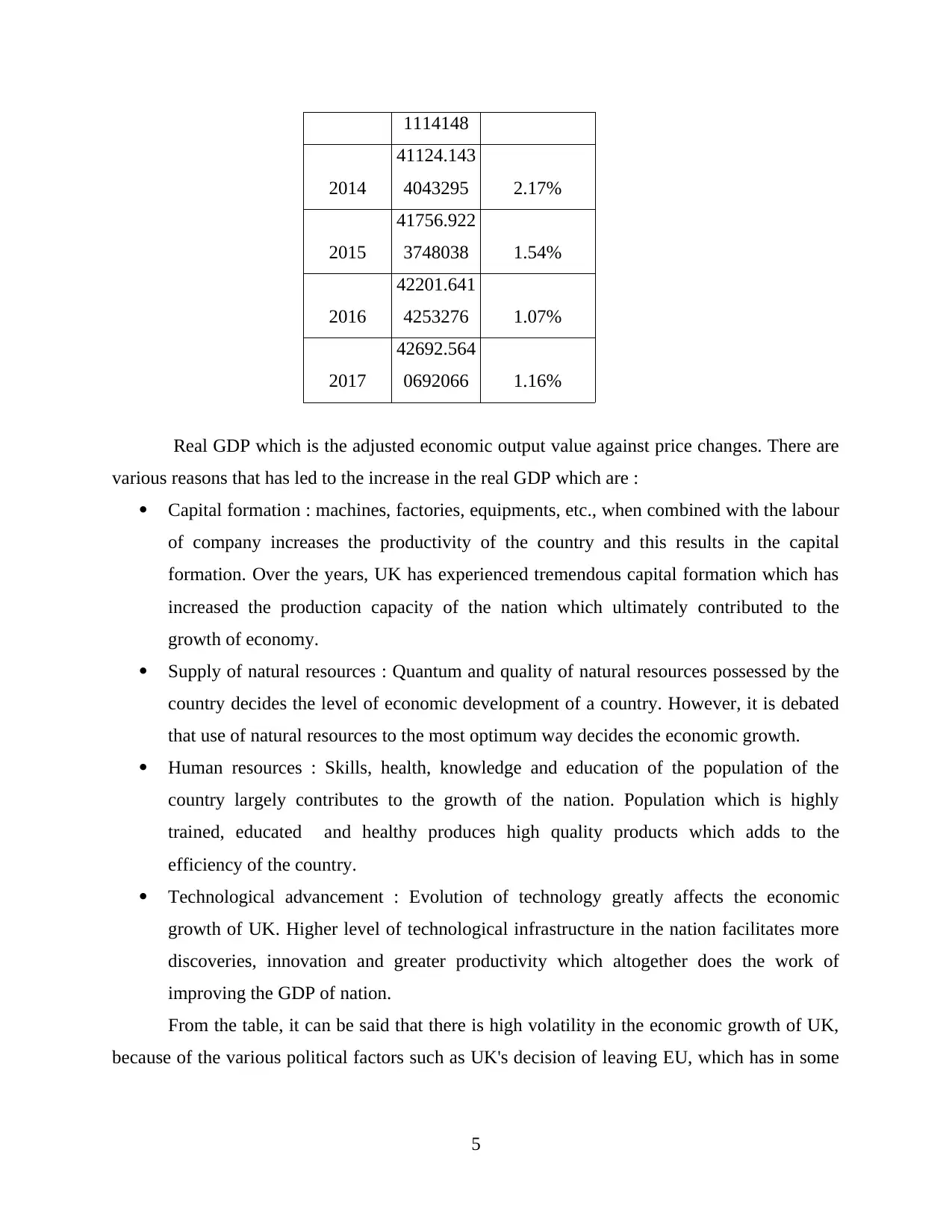
1114148
2014
41124.143
4043295 2.17%
2015
41756.922
3748038 1.54%
2016
42201.641
4253276 1.07%
2017
42692.564
0692066 1.16%
Real GDP which is the adjusted economic output value against price changes. There are
various reasons that has led to the increase in the real GDP which are :
Capital formation : machines, factories, equipments, etc., when combined with the labour
of company increases the productivity of the country and this results in the capital
formation. Over the years, UK has experienced tremendous capital formation which has
increased the production capacity of the nation which ultimately contributed to the
growth of economy.
Supply of natural resources : Quantum and quality of natural resources possessed by the
country decides the level of economic development of a country. However, it is debated
that use of natural resources to the most optimum way decides the economic growth.
Human resources : Skills, health, knowledge and education of the population of the
country largely contributes to the growth of the nation. Population which is highly
trained, educated and healthy produces high quality products which adds to the
efficiency of the country.
Technological advancement : Evolution of technology greatly affects the economic
growth of UK. Higher level of technological infrastructure in the nation facilitates more
discoveries, innovation and greater productivity which altogether does the work of
improving the GDP of nation.
From the table, it can be said that there is high volatility in the economic growth of UK,
because of the various political factors such as UK's decision of leaving EU, which has in some
5
2014
41124.143
4043295 2.17%
2015
41756.922
3748038 1.54%
2016
42201.641
4253276 1.07%
2017
42692.564
0692066 1.16%
Real GDP which is the adjusted economic output value against price changes. There are
various reasons that has led to the increase in the real GDP which are :
Capital formation : machines, factories, equipments, etc., when combined with the labour
of company increases the productivity of the country and this results in the capital
formation. Over the years, UK has experienced tremendous capital formation which has
increased the production capacity of the nation which ultimately contributed to the
growth of economy.
Supply of natural resources : Quantum and quality of natural resources possessed by the
country decides the level of economic development of a country. However, it is debated
that use of natural resources to the most optimum way decides the economic growth.
Human resources : Skills, health, knowledge and education of the population of the
country largely contributes to the growth of the nation. Population which is highly
trained, educated and healthy produces high quality products which adds to the
efficiency of the country.
Technological advancement : Evolution of technology greatly affects the economic
growth of UK. Higher level of technological infrastructure in the nation facilitates more
discoveries, innovation and greater productivity which altogether does the work of
improving the GDP of nation.
From the table, it can be said that there is high volatility in the economic growth of UK,
because of the various political factors such as UK's decision of leaving EU, which has in some
5
Paraphrase This Document
Need a fresh take? Get an instant paraphrase of this document with our AI Paraphraser
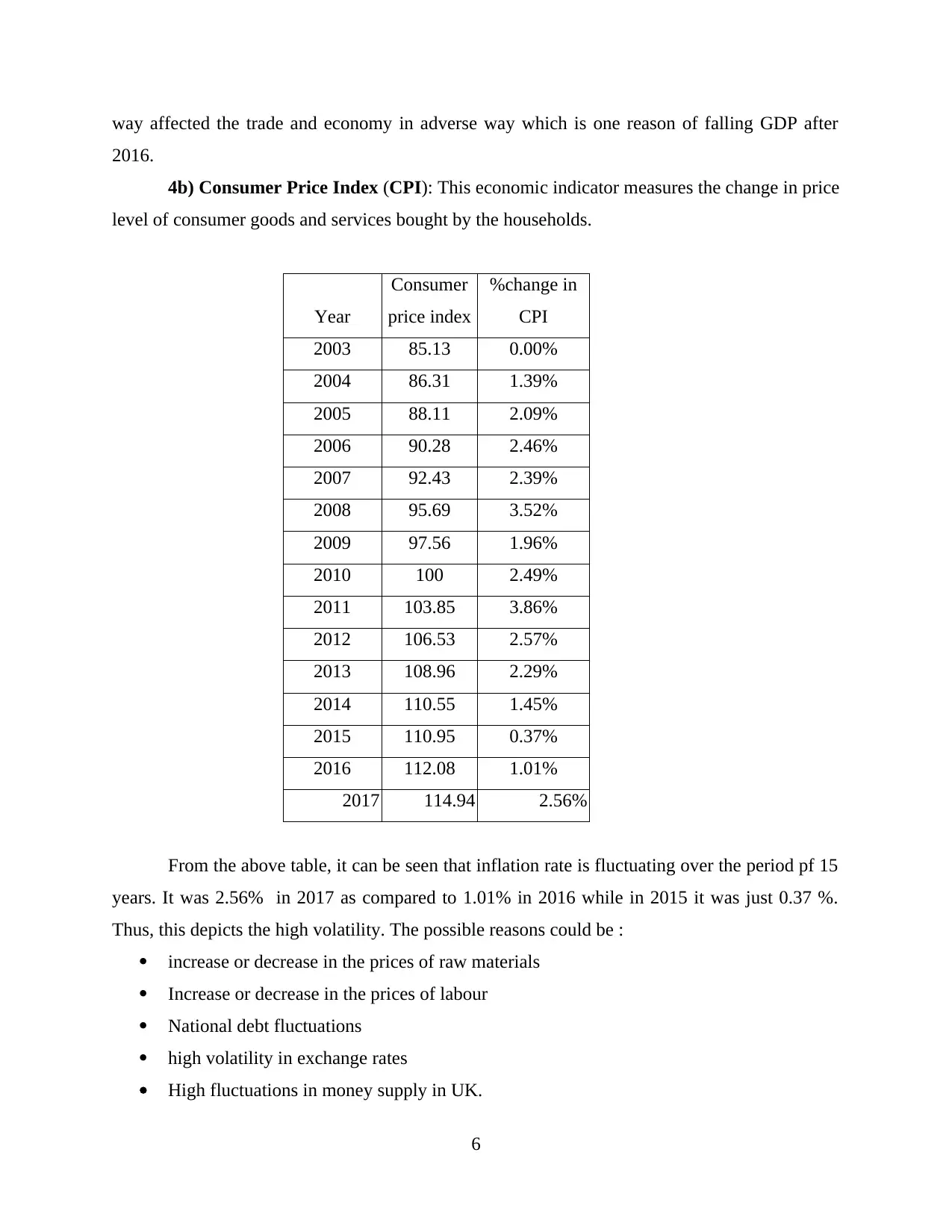
way affected the trade and economy in adverse way which is one reason of falling GDP after
2016.
4b) Consumer Price Index (CPI): This economic indicator measures the change in price
level of consumer goods and services bought by the households.
Year
Consumer
price index
%change in
CPI
2003 85.13 0.00%
2004 86.31 1.39%
2005 88.11 2.09%
2006 90.28 2.46%
2007 92.43 2.39%
2008 95.69 3.52%
2009 97.56 1.96%
2010 100 2.49%
2011 103.85 3.86%
2012 106.53 2.57%
2013 108.96 2.29%
2014 110.55 1.45%
2015 110.95 0.37%
2016 112.08 1.01%
2017 114.94 2.56%
From the above table, it can be seen that inflation rate is fluctuating over the period pf 15
years. It was 2.56% in 2017 as compared to 1.01% in 2016 while in 2015 it was just 0.37 %.
Thus, this depicts the high volatility. The possible reasons could be :
increase or decrease in the prices of raw materials
Increase or decrease in the prices of labour
National debt fluctuations
high volatility in exchange rates
High fluctuations in money supply in UK.
6
2016.
4b) Consumer Price Index (CPI): This economic indicator measures the change in price
level of consumer goods and services bought by the households.
Year
Consumer
price index
%change in
CPI
2003 85.13 0.00%
2004 86.31 1.39%
2005 88.11 2.09%
2006 90.28 2.46%
2007 92.43 2.39%
2008 95.69 3.52%
2009 97.56 1.96%
2010 100 2.49%
2011 103.85 3.86%
2012 106.53 2.57%
2013 108.96 2.29%
2014 110.55 1.45%
2015 110.95 0.37%
2016 112.08 1.01%
2017 114.94 2.56%
From the above table, it can be seen that inflation rate is fluctuating over the period pf 15
years. It was 2.56% in 2017 as compared to 1.01% in 2016 while in 2015 it was just 0.37 %.
Thus, this depicts the high volatility. The possible reasons could be :
increase or decrease in the prices of raw materials
Increase or decrease in the prices of labour
National debt fluctuations
high volatility in exchange rates
High fluctuations in money supply in UK.
6
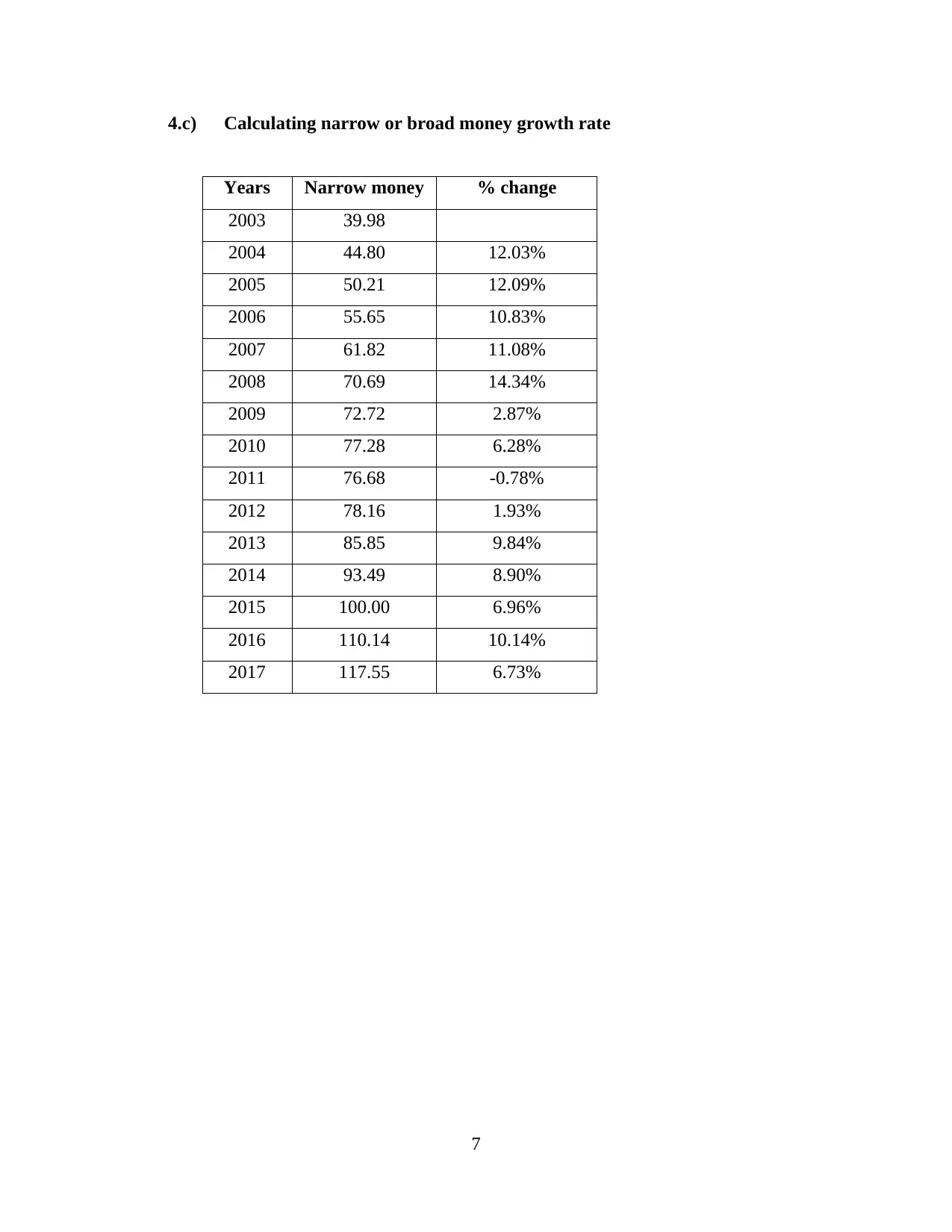
4.c) Calculating narrow or broad money growth rate
Years Narrow money % change
2003 39.98
2004 44.80 12.03%
2005 50.21 12.09%
2006 55.65 10.83%
2007 61.82 11.08%
2008 70.69 14.34%
2009 72.72 2.87%
2010 77.28 6.28%
2011 76.68 -0.78%
2012 78.16 1.93%
2013 85.85 9.84%
2014 93.49 8.90%
2015 100.00 6.96%
2016 110.14 10.14%
2017 117.55 6.73%
7
Years Narrow money % change
2003 39.98
2004 44.80 12.03%
2005 50.21 12.09%
2006 55.65 10.83%
2007 61.82 11.08%
2008 70.69 14.34%
2009 72.72 2.87%
2010 77.28 6.28%
2011 76.68 -0.78%
2012 78.16 1.93%
2013 85.85 9.84%
2014 93.49 8.90%
2015 100.00 6.96%
2016 110.14 10.14%
2017 117.55 6.73%
7
⊘ This is a preview!⊘
Do you want full access?
Subscribe today to unlock all pages.

Trusted by 1+ million students worldwide
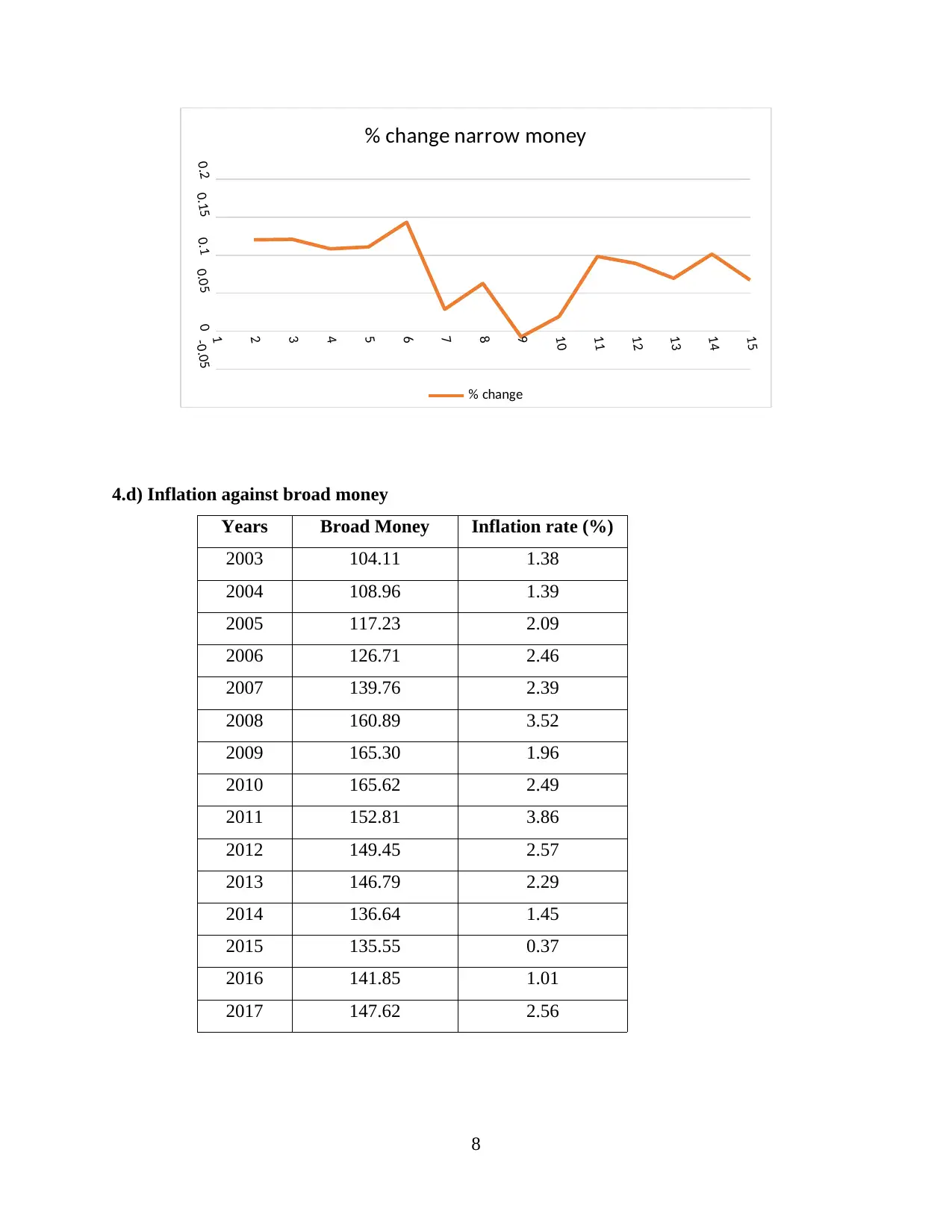
4.d) Inflation against broad money
Years Broad Money Inflation rate (%)
2003 104.11 1.38
2004 108.96 1.39
2005 117.23 2.09
2006 126.71 2.46
2007 139.76 2.39
2008 160.89 3.52
2009 165.30 1.96
2010 165.62 2.49
2011 152.81 3.86
2012 149.45 2.57
2013 146.79 2.29
2014 136.64 1.45
2015 135.55 0.37
2016 141.85 1.01
2017 147.62 2.56
8
1
2
3
4
5
6
7
8
9
10
11
12
13
14
15
-0.0500.050.10.150.2
% change narrow money
% change
Years Broad Money Inflation rate (%)
2003 104.11 1.38
2004 108.96 1.39
2005 117.23 2.09
2006 126.71 2.46
2007 139.76 2.39
2008 160.89 3.52
2009 165.30 1.96
2010 165.62 2.49
2011 152.81 3.86
2012 149.45 2.57
2013 146.79 2.29
2014 136.64 1.45
2015 135.55 0.37
2016 141.85 1.01
2017 147.62 2.56
8
1
2
3
4
5
6
7
8
9
10
11
12
13
14
15
-0.0500.050.10.150.2
% change narrow money
% change
Paraphrase This Document
Need a fresh take? Get an instant paraphrase of this document with our AI Paraphraser

Interpretation : There is a link between money supply and inflation. Increase in the
money supply if quicker than the real output of the country, this will result into the rise in
inflation rate. The obvious reason is that more money is supplied for same number of goods and
services. The same is observed from the table also. When the supply of money increased in the
year 2011, inflation rate also increased to 3.86 and when money supplied decreased n the year
2015, inflation also decreased to 0.37.
4. e) Inflation against unemployment rate
Years
Inflation rate
(%)
Unemployment
rate
2003 1.38 4.59
2004 1.39 4.75
2005 2.09 5.35
2006 2.46 5.26
2007 2.39 5.61
2008 3.52 7.54
2009 1.96 7.79
2010 2.49 8.04
2011 3.86 7.89
2012 2.57 7.53
2013 2.29 6.11
9
Broad Money
13/04/1900
17/04/1900
26/04/1900
05/05/1900
18/05/1900
08/06/1900
13/06/1900
13/06/1900
31/05/1900
28/05/1900
25/05/1900
15/05/1900
14/05/1900
20/05/1900
0246
Inflation rate (%)
Inflation rate (%)
money supply if quicker than the real output of the country, this will result into the rise in
inflation rate. The obvious reason is that more money is supplied for same number of goods and
services. The same is observed from the table also. When the supply of money increased in the
year 2011, inflation rate also increased to 3.86 and when money supplied decreased n the year
2015, inflation also decreased to 0.37.
4. e) Inflation against unemployment rate
Years
Inflation rate
(%)
Unemployment
rate
2003 1.38 4.59
2004 1.39 4.75
2005 2.09 5.35
2006 2.46 5.26
2007 2.39 5.61
2008 3.52 7.54
2009 1.96 7.79
2010 2.49 8.04
2011 3.86 7.89
2012 2.57 7.53
2013 2.29 6.11
9
Broad Money
13/04/1900
17/04/1900
26/04/1900
05/05/1900
18/05/1900
08/06/1900
13/06/1900
13/06/1900
31/05/1900
28/05/1900
25/05/1900
15/05/1900
14/05/1900
20/05/1900
0246
Inflation rate (%)
Inflation rate (%)
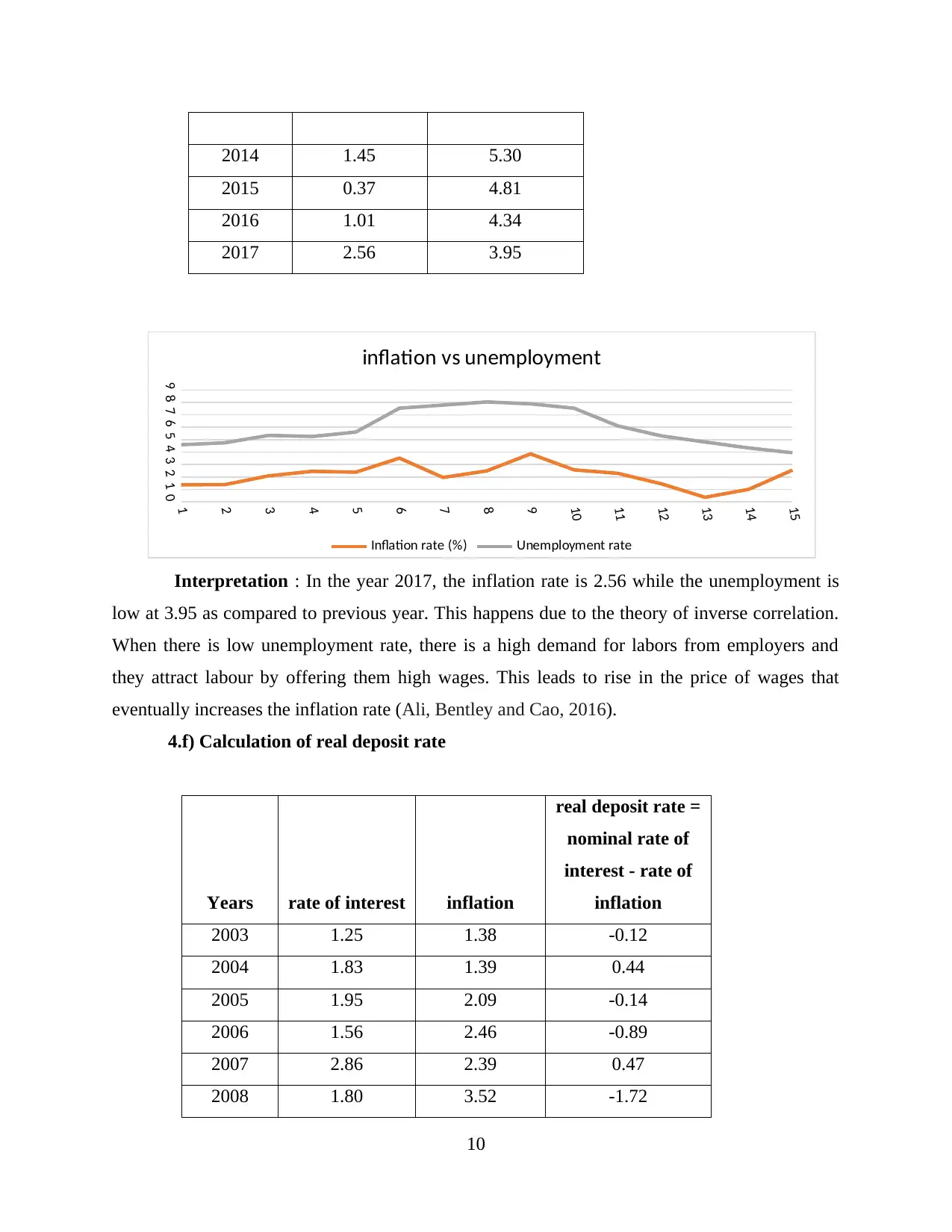
2014 1.45 5.30
2015 0.37 4.81
2016 1.01 4.34
2017 2.56 3.95
Interpretation : In the year 2017, the inflation rate is 2.56 while the unemployment is
low at 3.95 as compared to previous year. This happens due to the theory of inverse correlation.
When there is low unemployment rate, there is a high demand for labors from employers and
they attract labour by offering them high wages. This leads to rise in the price of wages that
eventually increases the inflation rate (Ali, Bentley and Cao, 2016).
4.f) Calculation of real deposit rate
Years rate of interest inflation
real deposit rate =
nominal rate of
interest - rate of
inflation
2003 1.25 1.38 -0.12
2004 1.83 1.39 0.44
2005 1.95 2.09 -0.14
2006 1.56 2.46 -0.89
2007 2.86 2.39 0.47
2008 1.80 3.52 -1.72
10
1
2
3
4
5
6
7
8
9
10
11
12
13
14
15
0123456789
inflation vs unemployment
Inflation rate (%) Unemployment rate
2015 0.37 4.81
2016 1.01 4.34
2017 2.56 3.95
Interpretation : In the year 2017, the inflation rate is 2.56 while the unemployment is
low at 3.95 as compared to previous year. This happens due to the theory of inverse correlation.
When there is low unemployment rate, there is a high demand for labors from employers and
they attract labour by offering them high wages. This leads to rise in the price of wages that
eventually increases the inflation rate (Ali, Bentley and Cao, 2016).
4.f) Calculation of real deposit rate
Years rate of interest inflation
real deposit rate =
nominal rate of
interest - rate of
inflation
2003 1.25 1.38 -0.12
2004 1.83 1.39 0.44
2005 1.95 2.09 -0.14
2006 1.56 2.46 -0.89
2007 2.86 2.39 0.47
2008 1.80 3.52 -1.72
10
1
2
3
4
5
6
7
8
9
10
11
12
13
14
15
0123456789
inflation vs unemployment
Inflation rate (%) Unemployment rate
⊘ This is a preview!⊘
Do you want full access?
Subscribe today to unlock all pages.

Trusted by 1+ million students worldwide
1 out of 19
Related Documents
Your All-in-One AI-Powered Toolkit for Academic Success.
+13062052269
info@desklib.com
Available 24*7 on WhatsApp / Email
![[object Object]](/_next/static/media/star-bottom.7253800d.svg)
Unlock your academic potential
Copyright © 2020–2025 A2Z Services. All Rights Reserved. Developed and managed by ZUCOL.





